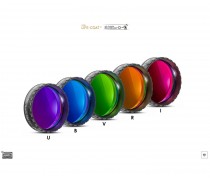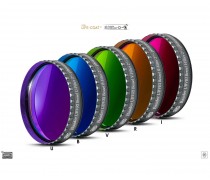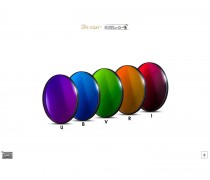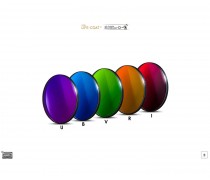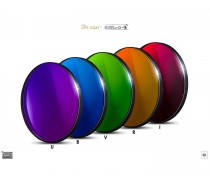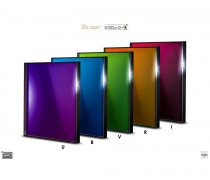Codice articolo: U2_27R
Astrodon Photometrics filters follow Sloan DSS specifications as closely as possible. The coating increases long-term stability and transmission.
![Astrodon Photometrics filters follow Sloan DSS specifications as closely as possible. The coating increases long-term stability and transmission. [EN] Astrodon Photometrics filters follow Sloan DSS specifications as closely as possible. The coating increases long-term stability and transmission. [EN]](https://www.teleskop-express.it/img/cms/astrodon-27r-sloan-filters_3.jpg)
>50% transmission from 320-385 nm
Peak transmission guaranteed > 95%
1/4-wave propagated wavefront prior to coating
Parfocal with all Astrodon filters
Astrodon Photometrics Sloan Filters
Astrodon Photometrics Sloan filters have evolved to our current Generation 2 filters with technical input from Las Cumbres Observatory Global Telescope Network (LCOGT) and others. Additional separation was included between the g' and r' filters to better avoid atmospheric sky glow . In particular the Y and z_s near-infrared filters were added to ensure that the filter, and not the detector, controlled the high-wavelength cut-off. This in contrast to our z' filter, which is simply a cut-on, or long-pass filter. Lastly, out-of-band blocking was tightened from an average to absolute specification to further minimize the already small leakage.
The Sloan Digital Sky Survery (SDSS) photometric filters were designed by Fukugita et al. (Ast. J., 411/4, April 1996, p. 1748-1756) to include five mostly non-overlapping filters covering 300 nm to the sensitivity limit of silicon CCD cameras near 1100 nm. They combined colored glass filters and short-pass dielectric coatings to steepen the low wavelength side of the bandpass. The [O I] sky glow line at 557.7 nm occurs between the g' and r' filters, and thus is reduced.
The SDSS photometric system is the most common filter set used today. The Hubble Space Telescope is equipped with an SDSS set that provides a large reference database for research. Much of photometry up to magnitude 23 will be done in this system with meter-class telescopes. The upcoming large collaborative survey projects (Large Synoptic Survey Telescope – LSST; Panoramic Survey Telescope and Rapid Response System – Pan-Starrs) will also use SDSS filters.
The disagram among the images on the top of the page is a compilation of actual (not theoretical!) scans of Astrodon Photometrics Sloan Generation 2 filters.
Specifiche tecniche:
Transmision range (>50%): 320-385 nm (+/- 3 nm typical)
Peak transmission guaranteed: > 95% (>90% for u')
Off-band transmission: <0.3% between 300 - 1100 nm
Substrate: Single striae-free fused silica
Surface accuracy: 1/4-wave propagated wavefront prior to coating
substrate parallelism: <0.5 arcminute
substrate thickness prior to coating: 3.000 +/-0.025 mm
Size: 1.25" mounted
![Astrodon Photometrics filters follow Sloan DSS specifications as closely as possible. The coating increases long-term stability and transmission. [EN] Astrodon Photometrics filters follow Sloan DSS specifications as closely as possible. The coating increases long-term stability and transmission. [EN]](https://www.teleskop-express.it/img/cms/astrodon-photometric-sloan-filters-transmission-ranges.jpg)
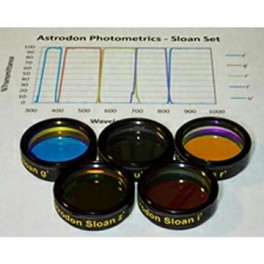 Ingrandisci
Ingrandisci 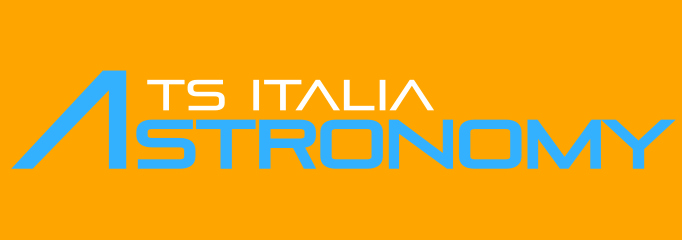
![[USATO] Fornax 52](https://www.teleskop-express.it/img/p/9/9/2/6/9926.jpg)
![[USATO] Astrografo RASA 11″](https://www.teleskop-express.it/img/p/9/1/8/7/9187.jpg)
![[DEMO] Camera QHY 268 Mono BSI](https://www.teleskop-express.it/img/p/6/5/0/1/6501.jpg)

![Astrodon Photometrics filters follow Sloan DSS specifications as closely as possible. The coating increases long-term stability and transmission. [EN] Astrodon Photometrics filters follow Sloan DSS specifications as closely as possible. The coating increases long-term stability and transmission. [EN]](https://www.teleskop-express.it/img/cms/astrodon-27r-sloan-filters_3.jpg)
![Astrodon Photometrics filters follow Sloan DSS specifications as closely as possible. The coating increases long-term stability and transmission. [EN] Astrodon Photometrics filters follow Sloan DSS specifications as closely as possible. The coating increases long-term stability and transmission. [EN]](https://www.teleskop-express.it/img/cms/astrodon-photometric-sloan-filters-transmission-ranges.jpg)
